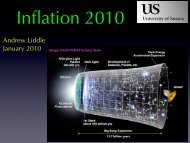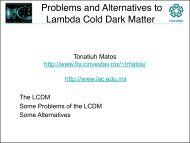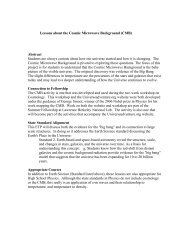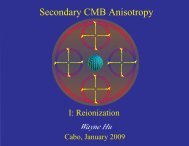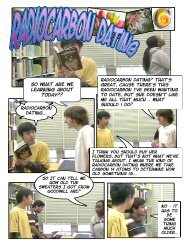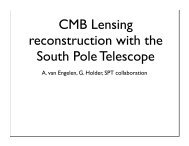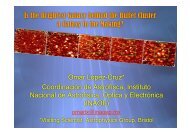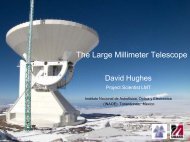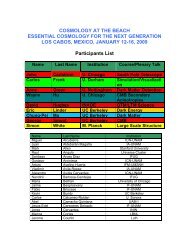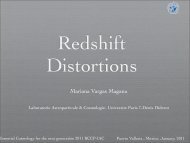PDF of Powerpoint Presentation 2
PDF of Powerpoint Presentation 2
PDF of Powerpoint Presentation 2
Create successful ePaper yourself
Turn your PDF publications into a flip-book with our unique Google optimized e-Paper software.
The Standard Model <strong>of</strong><br />
Particles and Interactions:<br />
What is the Universe Made <strong>of</strong><br />
and What Forces Drive its<br />
Evolution<br />
16 July 2007<br />
Stu Loken
Standard Model Part 2<br />
• As you learned Friday many particles were<br />
discovered in cosmic rays and early<br />
accelerators<br />
• These led to the Quark Model<br />
• Today we will go over what we have<br />
learned about elementary particles since<br />
the early experiments<br />
• The theory that has evolved from these is<br />
called the Standard Model <strong>of</strong> Particles and<br />
Interactions
New Particles
Modern History
More lepton and quark generations<br />
(heavy flavors)<br />
• Discovery <strong>of</strong> charm quark Ting, Richter 1974<br />
— m c ~1.5 GeV<br />
• Discovery <strong>of</strong> tau lepton Perl 1975<br />
— m τ ~1.8 GeV<br />
• Discovery <strong>of</strong> bottom quark Lederman 1977<br />
— m b ~4.7 GeV<br />
• Discovery <strong>of</strong> mediators <strong>of</strong> weak interactions: W ± ,Z 0 Rubia 1983<br />
— m Z ~ 90 GeV<br />
— m W ~80 GeV<br />
• Discovery <strong>of</strong> top quark D0 and CDF 1995<br />
— m t ~176 GeV !!!
The Nucleus<br />
• Nucleus is small and<br />
dense; it was thought for a<br />
while to be fundamental<br />
• But still as many nuclei as<br />
atoms<br />
• Simplification – all nucleii<br />
are made up <strong>of</strong> charged<br />
protons and neutral<br />
neutrons
Quarks<br />
• We now know that even protons<br />
and neutrons are not<br />
fundamental<br />
• They are made up <strong>of</strong> smaller<br />
particles called quarks<br />
• So far, quarks appear to be<br />
fundamental (“point-like”)
The Modern Atom<br />
• A cloud <strong>of</strong> electrons in<br />
constant motion around<br />
the nucleus<br />
• And protons and neutrons<br />
in motion in the nucleus<br />
• And quarks in motion<br />
within the protons and<br />
neutrons
Generations<br />
• The six quarks and the six<br />
leptons are each organized into<br />
three generations<br />
• The generations are heavier<br />
“Xerox” copies<br />
• “Who ordered the 2 nd and 3 rd<br />
generations?”<br />
• The quarks have fractional<br />
charges (+2/3 and -1/3) The<br />
leptons have charge -1 or 0
How did we discover the fundamental<br />
particles?<br />
At a nuclear reactor<br />
In cosmic rays<br />
With accelerators
Size inside atoms<br />
• The nucleus is 10,000<br />
times smaller than the<br />
atom<br />
• Proton and neutron are 10<br />
times smaller than nucleus<br />
• No evidence that quarks<br />
have any size at all !
What is the World made <strong>of</strong>?<br />
• The real world is not made <strong>of</strong> individual quarks<br />
(more on that later)<br />
• Quarks exist only in groups making up what we<br />
call hadrons: (proton and neutron are hadrons)<br />
• E.g. a proton is 2 up quarks and 1 down quark<br />
• We are all made from up and down quarks and<br />
electrons
Matter and Antimatter<br />
• For every particle ever<br />
found, there is a<br />
corresponding antimatter<br />
particle or antiparticle<br />
• They look just like matter<br />
but have the opposite<br />
charge<br />
• Particles are created or<br />
destroyed in pairs
Particles can decay<br />
• Particles may decay, i.e.<br />
transform from one to<br />
another<br />
• Most are unstable<br />
• Proton and electron are<br />
stable<br />
• Neutron can decay to<br />
electron and a proton<br />
• Energy appears to be<br />
missing. It is carried <strong>of</strong>f by<br />
a neutrino
What about Leptons?<br />
• There are six leptons, three charged and three<br />
neutral<br />
• They appear to be point-like particles with no<br />
internal structure<br />
• Electrons are the most common and are the only<br />
ones found in ordinary matter<br />
• Muons (µ) and taus (τ) are heavier and charged like<br />
the electron<br />
• Neutrinos have no charge and very little mass
Matter Summary<br />
• So all the universe is made <strong>of</strong> First Generation<br />
quarks and leptons<br />
• We now turn to how the quarks and leptons<br />
interact with each other, stick together and decay
Four Forces<br />
• There are four fundamental<br />
interactions in nature<br />
• All forces can be attributed to<br />
these interactions<br />
• Gravity is attractive; others can<br />
be repulsive<br />
• Interactions are also<br />
responsible for decay
Strong Force<br />
• In addition to their electric<br />
charge, quarks also carry<br />
a new kind <strong>of</strong> charge<br />
called color charge<br />
• The force between color<br />
charged particles is the<br />
“strong force”
The Gluon<br />
• The strong force holds<br />
quarks together to form<br />
hadrons<br />
• Its carrier particles are<br />
called gluons; there are 8<br />
<strong>of</strong> these<br />
• The strong force only acts<br />
on very short distances
Weak Force<br />
• Weak interactions are responsible<br />
for the decay <strong>of</strong> massive quarks<br />
and leptons into lighter quarks and<br />
leptons<br />
• Example: neutron to decay into<br />
proton + electron + neutrino<br />
• This is why all matter consists <strong>of</strong><br />
the lightest quarks and leptons<br />
(plus neutrinos)
Electroweak Force<br />
• In the Standard Model, the<br />
weak and the electromagnetic<br />
forces have been combined<br />
into a unified electroweak<br />
theory<br />
• At very short distances (~10 -18<br />
meters), the weak and<br />
electromagnetic interactions<br />
have comparable strengths<br />
• Force particles are photon, W<br />
and Z
What about Gravity?<br />
• Gravity is very weak<br />
• Relevant at macroscopic<br />
distances<br />
• The gravity force carrier, the<br />
graviton, is predicted but has<br />
never been seen
Interaction Summary
Neutron Beta Decay
Electron-Positron Annihilation
Top Production
Mysteries and Failures<br />
• The Standard Model is a theory <strong>of</strong> the universe<br />
• It provides a good description <strong>of</strong> phenomena<br />
observed by experiments<br />
• It is still incomplete in many ways: why 3<br />
generations? What is dark matter?
Is the Standard Model Wrong?<br />
• We need to go beyond the Standard Model in the<br />
same way that Einstein’s Theory <strong>of</strong> Relativity<br />
extended Newton’s laws <strong>of</strong> mechanics<br />
• We will need to extend the Standard Model with<br />
something new to explain mass, gravity, etc.
Three Generations<br />
• There are three sets <strong>of</strong><br />
quarks and three sets <strong>of</strong><br />
leptons<br />
• Why are there exactly<br />
three generations <strong>of</strong><br />
matter?<br />
• Why do we see only one<br />
in the real world?
What About Masses?<br />
• The Standard Model cannot<br />
explain why a particle has a<br />
certain mass<br />
• Physicists have theorized<br />
the existence <strong>of</strong> a new field,<br />
called the Higgs field,<br />
which interacts with other<br />
particles to give them mass<br />
• So far, the Higgs has not<br />
been seen by experiment
Grand Unified Theory<br />
• We believe that GUT will<br />
unify the strong, weak and<br />
electromagnetic forces<br />
• All three forces would be<br />
different aspects <strong>of</strong> the<br />
same, unified interaction<br />
• The three forces would<br />
merge into one at high<br />
enough energy
Supersymmetry<br />
• Some physicists<br />
attempting to unify gravity<br />
with the other fundamental<br />
forces have suggested<br />
that every fundamental<br />
particle should have a<br />
massive “shadow” particle
• Modern physics has theories for quantum<br />
mechanics, relativity and gravity but they do not<br />
quite work with each other<br />
• If we lived in a world <strong>of</strong> more than three spatial<br />
dimensions, these problems can be resolved<br />
• String theory suggests that in a world with three<br />
ordinary dimensions and some additional very<br />
small dimensions, particles are strings and<br />
membranes
• String Theory requires<br />
more than three space<br />
dimensions<br />
Extra Dimensions<br />
• These extra dimensions<br />
could be very small so that<br />
we do not see them<br />
• Experiments are now<br />
searching for evidence <strong>of</strong><br />
extra dimensions
Dark Matter<br />
• It appears that the<br />
universe is not made <strong>of</strong> the<br />
same kind <strong>of</strong> matter as our<br />
sun and the stars<br />
• The dark matter does exert<br />
a gravitational attraction<br />
on ordinary matter but has<br />
not been detected directly
The Accelerating Universe<br />
• Recent experiments<br />
using Type Ia<br />
Supernovae have shown<br />
that the universe is still<br />
expanding and the rate <strong>of</strong><br />
expansion is increasing<br />
• This acceleration must be<br />
driven by a new<br />
mechanism which has<br />
been named dark energy
The Expanding Universe<br />
• Studies <strong>of</strong> the most<br />
distant supernova ever<br />
detected indicates that<br />
the universe did go<br />
through a phase where<br />
the expansion slowed<br />
down<br />
• It is now speeding up
Recent Discoveries Indicate<br />
Particle Physics Has Reached a Singular Moment
• Today –Tevatron<br />
• Soon – Large<br />
Hadron Collider<br />
• Tomorrow –<br />
Linear Collider<br />
Current and Future<br />
Experimental Work
ATLAS at CERN
ATLAS Detector at CERN’s Large<br />
Hadron Collider<br />
Inner Tracking Detector
ATLAS – November 4, 2005 AM
Einstein’s Dream<br />
• Is there an underlying<br />
simplicity behind vast<br />
phenomena in Nature?<br />
• Einstein dreamed <strong>of</strong><br />
coming up with a unified<br />
description <strong>of</strong> the forces<br />
• But he failed to unify<br />
electromagnetism and<br />
gravity (GR)
planets apple<br />
gravity<br />
GR<br />
String theory?<br />
mechanics<br />
History <strong>of</strong> Unification<br />
Special relativity<br />
electric magnetic<br />
electromagnetism<br />
Quantum ElectroDynamics<br />
Electroweak theory<br />
Grand Unification?<br />
atoms<br />
Quantum mechanics<br />
Weak force<br />
γ-decay<br />
Strong force<br />
β-decay<br />
α-decay
A Promising Model –<br />
Supersymmetry(SUSY)<br />
• Additional symmetries have to be<br />
proposed to extend the SM to<br />
solve the Dark Matter problem<br />
• One approach is to double the<br />
particle spectrum by positing a<br />
symmetry that links fermions to<br />
bosons…giving a sparticle paired<br />
with each SM particle, differing by<br />
_ unit <strong>of</strong> spin<br />
• Originally studied for other<br />
reasons…
Problems Possibly ‘Solved’ by<br />
Supersymmetry<br />
• Dark Matter problem – the lightest SUSY particle is stable => candidate for<br />
Dark Matter<br />
• Explanation for how mass is generated in the SM => requires a heavy top<br />
quark, as was observed after the SUSY ‘prediction’<br />
Introduces a higher<br />
level <strong>of</strong> symmetry<br />
that stabilizes the<br />
theory against higher<br />
order corrections<br />
(solves the hierarchy<br />
problem)<br />
Provides for<br />
Unification <strong>of</strong> the<br />
forces into a single<br />
force at very high<br />
energies<br />
(alternatively, at very<br />
short distances or in<br />
the very early<br />
Universe)
Standard Model and Supersymmetry
SUSY and Dark Matter<br />
• Most SUSY models have unbroken R-parity that guarantees<br />
that lightest sparticle (LSP) is stable<br />
• LSP must be neutral – candidates are B W0 ~ ~ H ~ ν and ~ G ~<br />
• ~ ν is strongly disfavored by LEP and direct searches<br />
• Parameters m 1/2 (gaugino masses), m 0 (squark masses), tan<br />
β, sign(µ), A, specified at GUT scale, fully describes model.<br />
• LSP is usually B ~<br />
and mass controlled by m1/2
• Answers to<br />
origins <strong>of</strong> Dark<br />
Matter and Dark<br />
Energy likely<br />
very soon<br />
• Many exciting<br />
possibilities<br />
• One <strong>of</strong> several<br />
thrusts in<br />
particle physics<br />
today<br />
Answers coming?<br />
Expect a 21 st Century Revolution in Particle Physics
Conclusion<br />
• The Standard Model is a powerful synthesis that<br />
explains a huge number <strong>of</strong> observations in a<br />
simple framework. It is to physics what evolution<br />
is to biology.<br />
• There are many important questions beyond the<br />
Standard Model



